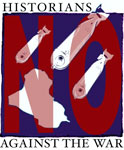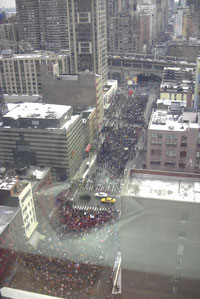
Virtual Movement Archive
Van Gosse, 2/17/03
Any number of excellent eyewitness accounts of this genuinely “historic” mobilization are circulating via the internet, and this report is not meant to supercede any of those. Rather, I will assess the goals of the mobilization, what happened since its initial conceptualization, and what appear to be its results—on the ground and internationally.
A February 15 mobilization in New York City was agreed to by United for Peace (later “and Justice” was added) soon after its October 25 founding. UFPJ was intended to unite and express the broad grassroots opposition to the war, and it quickly took shape as a campaign uniting dozens of national organizations and key local coalitions. In mid-November, via a series of open conference calls, we agreed first on a New York rally early in the New Year, and then, once word came that the Europeans had picked February 15, on that date.
The perspective that many of us had was that while the Washington DC marches organized by International ANSWER had been very effective in projecting a growing movement, one in New York could be both larger, and more genuinely representative of the multiracial base of the antiwar sentiment. New York alone, it was felt, could bring out the largest numbers, in large part because it had developed since 9/11 a network of neighborhood antiwar committees across all five boroughs that had few rivals in the country (Boston is the only comparable metropolitan area in terms of self-organization, as far as I know).
In sum, this proved to be a correct assessment, and both the size and character of the rally were key to its contribution to making February 15 effective on a global scale; certainly, millions rallying in Europe and elsewhere would have made a major statement at this decisive time, but to have the U.S. and even more New York step up as a constituent part of the “world saying no to war,” one day after Powell’s humiliation at the U.N, ratcheted up the impact measurably. Above all, it clarified that Bush has no mandate at home to face down the rest of the world. He has the power to make war, but from a very narrow platform. All told, a very good day, but it was a difficult road getting there.
First, UFPJ has operated literally on a shoestring. Until mid-January, it had almost no money, no staff and no office. Of course, experienced organizers at groups like IPS, Global Exchange, Peace Action, Democracy Rising and others contributed time and expertise. Co-Chair Leslie Cagan acted from late in the fall as an unpaid but essential coordinator of the whole campaign.
Having put nearly all its common energies into a nationwide day of coordinated local actions on December 10 (130 in all, getting lots of press), UFPJ then had to wait until after the holidays to hold its second national meeting in New York City on January 7. It was only then that practical organizing began for February 15, extremely late in normal terms.
An office was opened, donated by 1199 (the health care union), a staff was hired, and money trickled in. Permits for opening and closing rallies and a march through midtown Manhattan were filed, all by mid-January. Belatedly, the word went out nationally, but in NYC itself a huge volunteer effort kicked in, powered by the energies of a new, younger left that had been building since 9/11, but benefiting from decades of experience among veterans like Cagan and others she helped recruit. (Obviously, I’m compressing a much more complex situation, which I observed only via email, but the raw numbers in terms of leaflets distributed—900,000—and the reports of citywide outreach, were very impressive.)
The first indication of how effective this rally could be was the line-up of speakers. By the end of January, they included Desmond Tutu, Julian Bond, Danny Glover, and many others. But no permits had been granted. Then in the last 10 days, there was the well-known struggle with the New York Police, who were able to ban any kind of legal march.
So what happened? In effect, the NYPD handed over midtown Manhattan to several hundred thousand protesters. Their goal was to disperse, contain, and muddle, presumably to avoid the spectacle of a single big crowd. What were they thinking? Did they assume that in the cold, constantly deterred by barriers, barricades and trucks, people would give up and go home? Perhaps they had no real idea of the numbers the UFPJ organizers expected. In the end, it turned into dozens and dozens of mini-rallies, street occupations really, spread out over three or more avenues and dozens of blocks. Most people never heard any of the speakers, despite multiple video screens set up along First Avenue. It didn’t matter. What mattered was that we were there, visibly occupying all of midtown.
There are plenty of accounts by others who, like me, just marched as part of that enormous dispersed crowd, so any personal impressions are offered humbly. It was emphatically multigenerational, and in comparison to marches in DC, distinctly multicultural—though certainly whiter than New York itself is. I was struck by the militant union contingents, from the Transit Workers Union to the City University’s Professional Staff Congress. Music and the city’s characteristic tough ebullience were everywhere. Looking across 59th Street next to Bloomingdale’s around 12:30 to check out a marching jazz band, only to see Jerry Springer striding diffidently behind them, was a favorite moment. I should also note that the cops seemed confused whenever I talked to them, and among the beat ones, resigned to their roles as the equivalent of sheepdogs.
What really struck me, though, was a larger feeling, a collective consciousness I had not sensed since 1969-1970, at the time of the Moratorium and then Kent State. Even allowing for teenage naiveté and the golden haze of hindsight, my memory was that the whole city then seemed to be in a permanent state of mobilization. On the streets, people seemed to recognize each other as they marched. “Our Streets!” was the constant cry last Saturday, and this was the first time it had really felt that way in many years. Certainly there have been lots of marches and mobilizations in between. Some were quite militant but others, especially those in DC where one feels like a different species of tourist, were essentially dutiful—straggling along instead of massed, with chants muted. Even the best ones I remember, “taking the street,” were far too small for us not to be aware of the action’s marginality.
So, here’s the optimism of the moment, of the will if you want. I think the narrow cabal around Bush (if this is a “class fraction” it isn’t a big one) has, completely contrary to their hegemonic aspirations, brought a new kind of international popular front into being. They may well get their war, but it will be neither splendid nor little. A few years ago, late in the Clinton years, I read a special issue of The National Interest, one of the major neoconservative policy journals, devoted to the subject of U.S. hegemony, and how long it would last. The foreign policy scholars therein considered that any real threat was hard to envision. The best bet was a pan-European pole, balancing the U.S., with its own interests and clout. All agreed any such possibility was decades off. Think again.
Where does that leave us here? Here are a few observations, based both on participating in UFPJ, and on observing the very rapid growth of the antiwar movement out in 4-1 Republican Lancaster County, Pennsylvania.
First, the “American people” as a whole are neither narcotized nor lacking in progressive convictions. By and large, they have resisted the overwhelming push to war backed by a supine press corps. Taking into account the plebiscitary character of polling, and the genuine trauma of 9/11, they have shown good sense, and above all, they have shown that the “Vietnam Syndrome” is an ongoing, maturing influence.
Second, we must resist the urge to pretend that this upsurge of antiwar activism is all new and unprecedented, “not seen since the Vietnam War.” Certainly, a full-scale ground war, without any evident cause, is new and unprecedented, but the rolling wave of the past six to twelve months is very much the product of accumulated skills, and layers of activists from the peace, solidarity and human rights movements of the 1980s, and the anti-globalization campaigns of the 1990s.
Third, our biggest immediate problem is the implosion of the Democratic Party, its slow motion unraveling under Clinton’s direction and since. From the late 1960s through the Gulf War, while the party as a whole was deeply compromised, a significant number of progressives were in place, to express an anti-interventionist position that on occasion became party policy. The residual weight of that politics could be seen in the unexpected rejection by 5 out of 8 House Democrats of their own leader, Dick Gephardt, in voting against the October resolution. But we are still very far from being able to generate real legislative vehicles that can be fought out, district-by-district and state-by-state. Right now, all we have is the streets, and that’s not enough. The rush by almost all the announced presidential candidates to affirm their anti-Iraq, pro-war credentials is testament to this problem, though the tentative entrance into the race of Dennis Kucinich on the left (joining Al Sharpton), and possibly General Wesley Clark on the center-right, may break open this disgraceful “consensus politics.”
